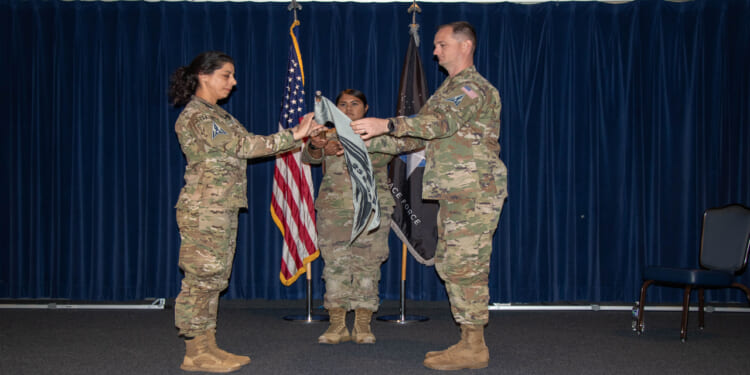The U.S. Air Force has reactivated the 23rd Electronic Warfare Squadron to enhance electromagnetic spectrum operations and address evolving aerial combat threats.
The United States Air Force has added a new electronic warfare squadron to its ranks, addressing the changing threats of aerial combat in the twenty-first century.
On Tuesday, the 350th Spectrum Warfare Wing at Eglin Air Force Base (AFB), Florida, announced that the 23rd Electronic Warfare Squadron (EWS) was reactivated at a ceremony last week. The unit’s mission will be to provide greater intelligence in the electromagnetic spectrum.
It will carry the legacy of the 23rd Fighter Squadron, the “Fighting Hawks,” which was first raised in December 1939 as the 23rd Pursuit Squadron (Interceptor). It was designated as the 23rd Fighter Squadron three years later and saw action in the Second World War in Europe.
More recently, it took part in combat operations in 1991’s Operation Desert Storm and the Global War on Terror (GWOT) until it was inactivated in August 2010.
“The 23rd Electronic Warfare Squadron will be the shield that protects our forces, the sword that disrupts our enemies, and the eyes that provide critical intelligence in the electromagnetic spectrum,” said U.S. Air Force Lt. Col. Luke Marron, commander of the squadron.
Marron previously served as the former commander of Detachment 1 of the 350th Spectrum Warfare Group (SWG), which now forms the basis of the 23rd EWS.
According to the 350th Spectrum Wing, “The 23rd EWS supports mission data file (MDF) reprogramming efforts for command and control, intelligence, surveillance and reconnaissance (C2ISR) platforms, combat rescue platforms and expendables for the Combat Air Force (CAF), including the High-Speed Anti-Radiation Missile (HARM).”
In addition, the 23rd EWS will provide service-wide support for a variety of Electromagnetic Warfare (EW) systems, including reprogramming existing systems as needed and “exploitation testing” of any “foreign threat systems.”
“As we stand here today… I’m reminded of the importance of service and sacrifice,” Marron added. “Service and sacrifice defined the 23rd Fighter Squadron, and will continue to define the 23rd Electronic Warfare Squadron.”
Why Are These Electronic Warfare Operations Now Necessary?
The reactivation of the 23rd EWS highlights the evolving nature of modern aerial combat and the requirements for maintaining air superiority.
“The movement, maneuver, and employment of joint forces, as well as achieving strategic and operational objectives, depend highly on the electromagnetic spectrum (EMS).
As adversaries increasingly challenge forces in this area, EMS superiority is required to gain and maintain control in all domains. Accordingly, a comprehensive understanding of the EMS is critical to gaining and maintaining the desired degree of EMS control,” An Air Force Doctrine Publication from December 2023 explained.
The role of the EMS in conventional warfare has also been understood since the Cold War, including controlling it, maintaining access, and denying access to an adversary via jamming.
“Once a signal is detected, forces must work to reprogram systems to counter it, which during the Cold War, could take weeks to months as the signal had to be sent back to a lab, a fix devised, and then sent back to the field,” Defense Scoop explained.
The situation is vastly different today, and the United States can’t afford to fall behind. As has been seen in the ongoing conflict in Ukraine, both sides are employing EW platforms to disrupt the other’s drones, missiles, and communications.
U.S. officials have warned that in a dispute with China, control of the EMS could be as critical as control of the seas and skies. And that is where the 23rd EWS could be tested in real time.
About the Author: Peter Suciu
Peter Suciu has contributed over 3,200 published pieces to more than four dozen magazines and websites over a thirty-year career in journalism. He regularly writes about military hardware, firearms history, cybersecurity, politics, and international affairs. Peter is also a Contributing Writer for Forbes and Clearance Jobs. He is based in Michigan. You can follow him on Twitter: @PeterSuciu. You can email the author: [email protected].
Image Credit: Wikimedia Commons/ Emily Peacock.
















